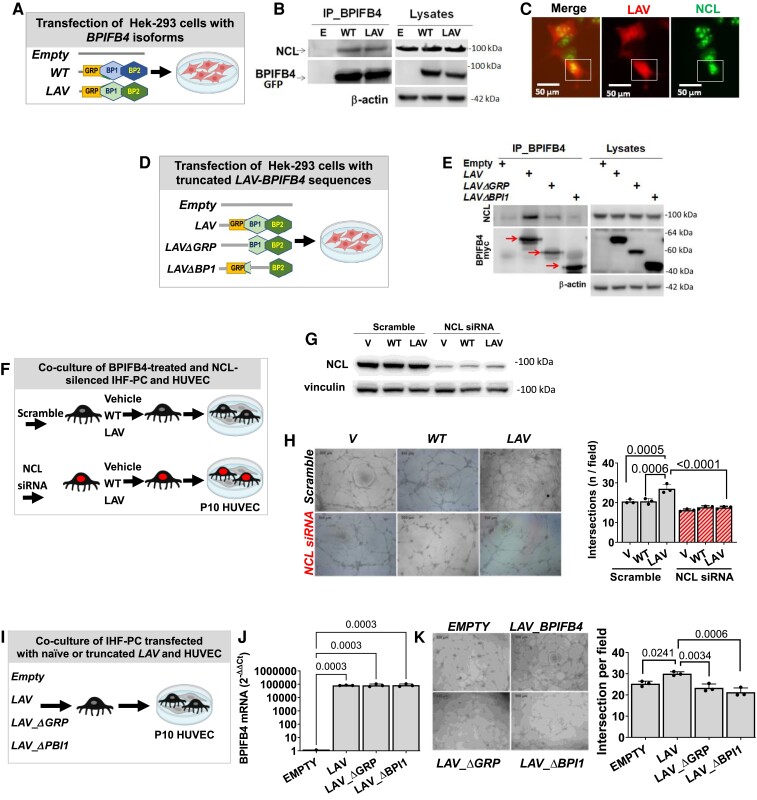Figure 5.
LAV-BPIFB4 physically interacts with NCL improving angiogenesis. The binding between BPIFB4 and NCL was determined using co-immunoprecipitation assays. (A) Cartoon showing the BPIFB4 transfection groups. (B) Lysates from Hek-293 transfectants expressing the BPIFB4 isoforms were immunoprecipitated with anti-BPIFB4, resolved by SDS-PAGE (10%), and probed with anti-NCL antibody (left panel). Lysate aliquots were loaded to verify transfection and immunoprecipitation efficiencies (right panel). (C) The subcellular localization of exogenous LAV-BPIFB4 and endogenous NCL in transfected Hek-293 was determined using double staining immunofluorescence using anti-BPIFB4 polyclonal (red) and anti-NCL monoclonal (green) antibodies. White squares point to the punctate area of colocalization between LAV-BPIFB4 and NCL. (D) Schematic representation of BPIFB4 constructs used for transfection. (E) Lysates from Hek-293 transfectants expressing deleted forms of LAV-BPIFB4 were immunoprecipitated with anti-BPIFB4 antibody, resolved by SDS-PAGE (10%), and probed with indicated antibodies (upper panel). (F) Schematic of the experiment in which IHF-PCs were silenced with siRNA against NCL or scramble siRNA and then exposed to the conditioning with BPIFB4 recombinant proteins before undergoing the Matrigel assay with late passage HUVECs. (G) Confirmation of effective silencing of NCL by siRNA. Western blotting and bar graph showing the data of different groups (n = 3 biological replicates/group). (H) Representative phase-contrast images of the six experimental groups. Bar graph showing that NCL silencing abolished the pro-angiogenic effect of LAV-BPIFB4 conditioned aged IHF-PCs (n = 3 biological replicates/group, ANOVA followed by Tukey's multiple comparisons test). (I) Schematic of the experiment in which IHF-PCs were transfected with the whole LAV-BPIFB4 sequence or truncated mutants impeding the interaction of the encoded protein with NCL. (J) Effective expression of the transgenes is shown at the mRNA. ANOVA followed by Tukey's multiple comparisons test. (K) Representative phase-contrast images of the six experimental groups. Bar graph showing that IHF-PCs transfected with the whole LAV-BPIFB4 sequence have a pro-angiogenic capacity, which is negated to aged IHF-PC transfected with the truncated mutants (n = 3 biological replicates/group, ANOVA followed by Tukey's multiple comparisons test.

